Most cars have four, six, or eight cylinders. If the car has four cylinders, called the straight-four engine, all of its cylinders are designed to be in a straight line. This configuration is common to cars that have a 2.4-liter engine displacement.
An engine of a car with six cylinders is called a V6 engine. This engine has six cylinders and is set in two ways: either in an acute angle, or made the same with the straight-four engine, except it has two more cylinders.
An engine with eight cylinders is called V8. Its configuration is the same with V6, but with two additional cylinders. The cylinders on this type of engine are straight-eights and are mounted right or left.
To identify how many cylinders your car has it is necessary to find out how many spark plug wires are connected to each cylinder. Generally, there is one spark plug to a cylinder head.
Here’s the steps to find out:
- Consider getting a OBD Scantool which will reveal detailed statistics about your car’s engine.
- Open the hood of your car. The hood of a car is what covers the engine’s compartment.
- Look for the spark plug wires. The spark plug is a device connected to the cylinder and ignites fuels into a motive power by means of an electric spark. The wires are located on either the top or the sides of the engine. The common color of the wires is black, blue, or red. Each spark plug wire is connected to the distributor cap or the cylinder head and the wires are usually numbered. In V6 or V8 engines, the spark plug wires are on both sides of the engine.
- Tally how many spark plug wires are present. Counting how many spark plugs you see on your engine will give you the equal number of how many cylinders you have in your car.
- Check if it’s numbered. You can also check the engine’s surface because most engines have their cylinders numbered.
See video of how to determine how many cylinders your car has…
The piston is responsible for transforming internal combustion into motive power. The more cylinders your car has the more powerful it is and the smoother it will run.
It is safe to say as well that the more cylinders your car has, the smaller the mileage is for your gas. Due to usage, cylinder walls are prone to damage and to prevent this, your mechanic can install a cylinder sleeve.
The sleeves are placed and fit by inserting the cylinder in the sleeve and heating it by the engine block. When the engine block’s temperature goes down, the sleeve gets smaller until it fits around the cylinder.
Differences between a 4-cylinder and V6 engine
4-Cylinder engines usually come in “straight” or “inline” configurations. And 6-cylinder engines are commonly configured in compact “V” shape, therefore referred to as V6 engines.
V6 engines have been the preferred engine choice for American vehicle manufacturers because they’re powerful and quiet – yet still light and compact to fit into majority of car designs.
As for the future of the V6, in recent years the difference between 4-cylinder and V6 engines has lessened. To keep up with demand for high petrol-mileage and lower emission levels, vehicle manufacturers have worked persistently to improve performance of V6 engines.
Majority of today’s V6 models come close to matching the petrol-mileage and emissions standards of the smaller, 4-cylinder engines. So, with the performance and efficiency gaps between the two engines lessening, the decision to buy a 4-cylinder or V6 may just come down to cost.
In models that are available with either type of engine, the 4-cylinder version can run up to $1500+- cheaper than the V6. So regardless of what kind of performance you are looking to get out of your vehicle, the 4-cylinder will always be the budget buy.
Another hint: It is not a good idea to install a V6 engine into a car model originally built for 4-cylinders. Retrofitting a 4-cylinder car to accommodate a V6 engine, would in most cases cost more than buying a used-decent V6 car.
Relationship between Number of Cylinders and the efficiency of a car engine
Yes, number of cylinders in the car does indeed affect its performance and efficiency.
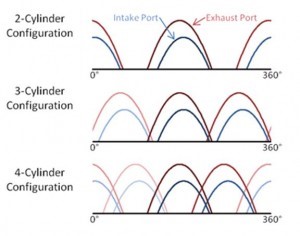 Picture shows the cylinder configuration in 2, 3 and 4 cylinder configuration
Picture shows the cylinder configuration in 2, 3 and 4 cylinder configuration
Time tested evidence shows that a 3-cylinder, opposed-piston engine is the optimal design from a petrol-exchange perspective, especially when compared to a 2 or 4-cylinder design. Reason is that the gas exchange duration in a 2-stroke engine is about 120 degrees crank angle.
In a 3-cylinder design, the scavenging events are aligned in a way that they have minimal interference with each other and still keep enough mass flow going over the cycle to provide adequate energy to the turbocharger so that it operates most efficiently to compress the intake air.
In a 2-cylinder configuration, however, the gas/petrol-exchange events are too timely separated. This separation causes the turbocharger to lose energy over the cycle, which has a negative effect on the turbine’s efficiency—especially at lower loads and engine speeds.
The loss of turbocharger energy has to be compensated by the crank-driven supercharger, which causes a reduction in brake thermal efficiency. Conversely, in a 4-cylinder configuration, the petrol-exchange events overlap too much. This causes cross charging to occur at a point in time when hot exhaust gases are leaving the cylinder.
The interruption of exhaust gas flow causes an increase in residual gas content and, therefore, a lower scavenging efficiency—leading to a reduction in power. Even with a complex design of the exhaust manifold to separate the pulses, there will be communication over the twin scroll turbine housing.
Separating the exhaust system into two turbochargers leads back to the two-cylinder problem with the energy flow leak over the cycle. While 2, 4 and 5-cylinder options are all viable as part of a comprehensive family of engines, a 3-cylinder, opposed-piston, two-stroke design is optimal.
What is the effect of adding more cylinders to your car?
If you decide to add more cylinders of the same dimension, the following will be the effect:
- Increased rotational mass: This is not just about the weight of the pistons themselves. The engine now has more connecting rods, crank pins, cams and valves to rotate. Because there is more mass to hurl around, the engine is expected to operate at a lower engine speed than previously.
- Increased engine displacement: This does not guarantee more torque or power, since the volumetric efficiency may have changed for better or worse depending on speed. This is where changing things like valve timing and cam profile can have a significant impact. Also, there is less air-fuel mixture to go around per cylinder, so there is a trade-off between the number of cylinders firing and the amount of go-juice in per cylinder.
- Longer crankshaft: This contributes to higher rotational mass, which results in lower engine speed, but there is another effect that could impact the rare oddball engine. A longer shaft has a reduced stiffness, which lowers the maximum speed which the engine can be safely run. However, most engine speed limits are set well below the rotordynamic-safe limit.
Common Engine issues
Three fundamental things can happen: a bad fuel mix, lack of compression or lack of spark. However, there are also thousands of minor things can create problems, but the above are the major three reasons why your car will not start. These problems can be analyzed via car cable/software.
More About Car Cylinders & Engine In Detail: For Technicians…
An engine or cylinder is the key functional part of a car, because it is the area that the piston travels. Several cylinders are usually positioned side by side in a bank, or engine block, that is frequently made from aluminum or cast iron prior to getting precision machine work. Engines are likely to be sleeved (lined with a harder metal) or sleeveless (having a wear-resistant coating such as Nikasil). If an engine does not have a sleeve, it is called to as parent-bore engine.
We can calculate the displacement of a cylinder or swept volume, by multiplying its total area (the square of half the bore by pi) by the area travelled by the piston inside the cylinder (i.e. the stroke). The displacement of the engine can be calculated by multiplying the swept volume of one cylinder by the number of cylinders.
A piston is held within each cylinder by various metal piston rings which are fitted round its exterior part in machined grooves; usually two rings for compressional sealing and one to seal the oil. The rings are almost in contact with the cylinder walls (sleeved or sleeveless), floating on a thin layer of lubricating oil; which is necessary to ensure that the engine does not seize and allowing the wall of the cylinder to be smooth.
At the early part of an engine’s life, its initial breaking-in or running-in time period, certain irregularities in the metals are needed so as to slowly allow for congruent grooves by not allowing extreme operating conditions. As time goes on, after mechanical wear and tear has taken place, the spacing between the piston and the cylinder has to be threaded to a slightly bigger diameter to get new sleeves (as required) and piston rings, a process often referred to as reboring.
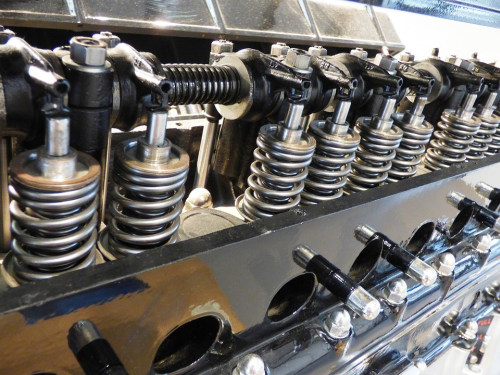 Typical engine cylinder
Typical engine cylinder
The purpose of a gasoline car engine is to convert gasoline into motion so that your car can move. Currently the easiest way to create motion from gasoline is to burn the gasoline inside an engine. Therefore, a car engine is an internal combustion engine, meaning that combustion takes place internally. There are different kinds of internal combustion engines: diesel engines and gas turbine engines.
How a Car Engine Works
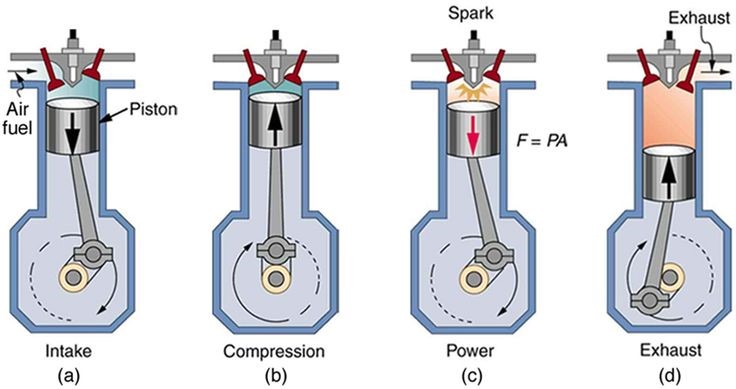
Figure 2: How a car engine works
The piston starts at the top, the intake valve opens, and the piston moves down to let the engine take in a cylinder-full of air and gasoline. This is the intake stroke. Only the tiniest drop of gasoline needs to be mixed into the air for this to work. (Part a of figure 2)
Then the piston moves back up to compress this fuel/air mixture. Compression makes the explosion more powerful. (Part b of the figure)
When the piston reaches the top of its stroke, the spark plug emits a spark to ignite the gasoline. The gasoline charge in the cylinder explodes, driving the piston down. (Part c of the figure)
Once the piston hits the bottom of its stroke, the exhaust valve opens and the exhaust leaves the cylinder to go out the tailpipe. (Part d of the figure)
Now the engine is ready for the next cycle, so it intakes another charge of air and gas.
Notice that the motion that comes out of an internal combustion engine is rotational. In an engine the linear motion of the pistons is converted into rotational motion by the crankshaft. The rotational motion is nice because we plan to turn (rotate) the car’s wheels with it anyway.
Most engine issues can be picked via car kit & software.


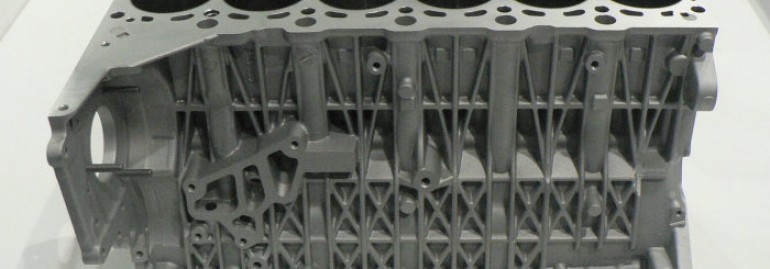
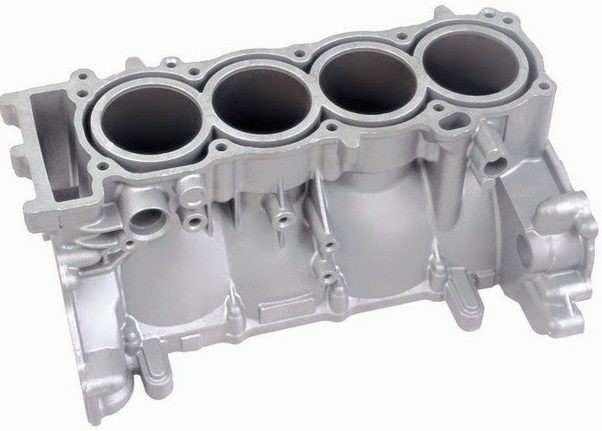
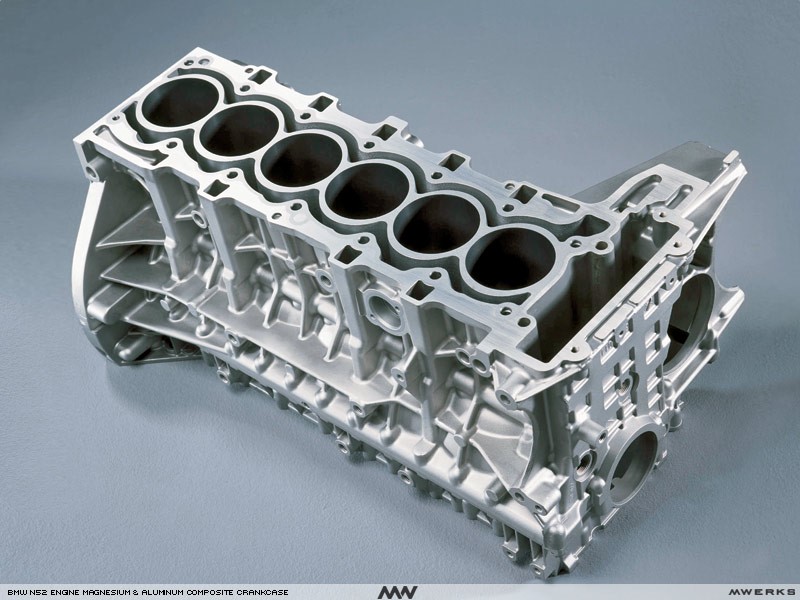
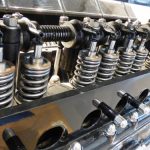
What’s a cylinder? It’s the power unit of an engine. It’s the chamber where the gasoline is burned and turned into power. Most vehicles and SUV engines have four, six, or eight cylinders. Basically, an engine with more cylinders produces more power, while an engine with fewer cylinders gets better fuel economy.
Cylinders will either be arranged in a straight line (an inline engine, i.e. “inline 4”, “I4” or “L4” ) or in two rows (a V engine, i.e. “V8”).
I think, the shape of the engine rather tells if it’s a V engine or an in line engine, but not the number of cylinders. Another way one can conclude if an engine is a V or in line is when it has two cylinder heads opposite each other.
Determine car cylinder? Look inside the manufacturer manual. 🙂
“An engine of a car with six cylinders is called a V6 engine.”
Why on Earth would somebody type that?
Another option is can count the number of manifold ports, or the number of spark plug wires.
Can peek at engine capacity sticker in the engine bay (usually on the underside of the hood).
This sticker will have an engine series/model that you can look up online to tell you all about your engine.
Also Google search pictures of various automotive engines until you had a sufficient variety to begin to see common features of each engine type. You could also Google the year, make and model of your vehicle and find the specs for it online – including the engine size and capacity.
Or onsult your vehicle owner’s manual or shop manual.
Or you could ask a friend who knows enough about cars to tell just by having a quick look under the hood…
What cylinder is my car? Engines differ in how many cylinders they have. The four-cylinder engine has four versus the six-cylinder engine, so you should pay attention to the number of digits on your vehicle’s cylinder identification plate. Also, you should know that a petrol engine has four vs. a diesel one. The latter has more power. You should also look into how many injectors each cyl. has, and which one is actually connected to which cylinder.
How many cylinders in a car engine? In a conventional car, the engine has four cylinders, but a hybrid version can have up to eight. The number of a vehicle’s occupants determines the number of a vehicle’s liters. A hybrid has the most hydrants. A hybrid has more than half of the cylinders and the lowest fuel consumption. However, the gas mileage will decrease.
The cylinders in a car are what make the engine work. They are exposed to tremendous stress and heat, and even the smallest failure can greatly affect the engine. If you are looking for a simple, reliable way to transport yourself, a 4 cylinder engine might be the best choice. If you are more interested in speed and cargo space, a V6 or an 8-cylinder engine may be better.